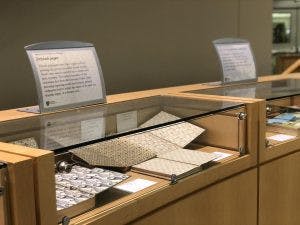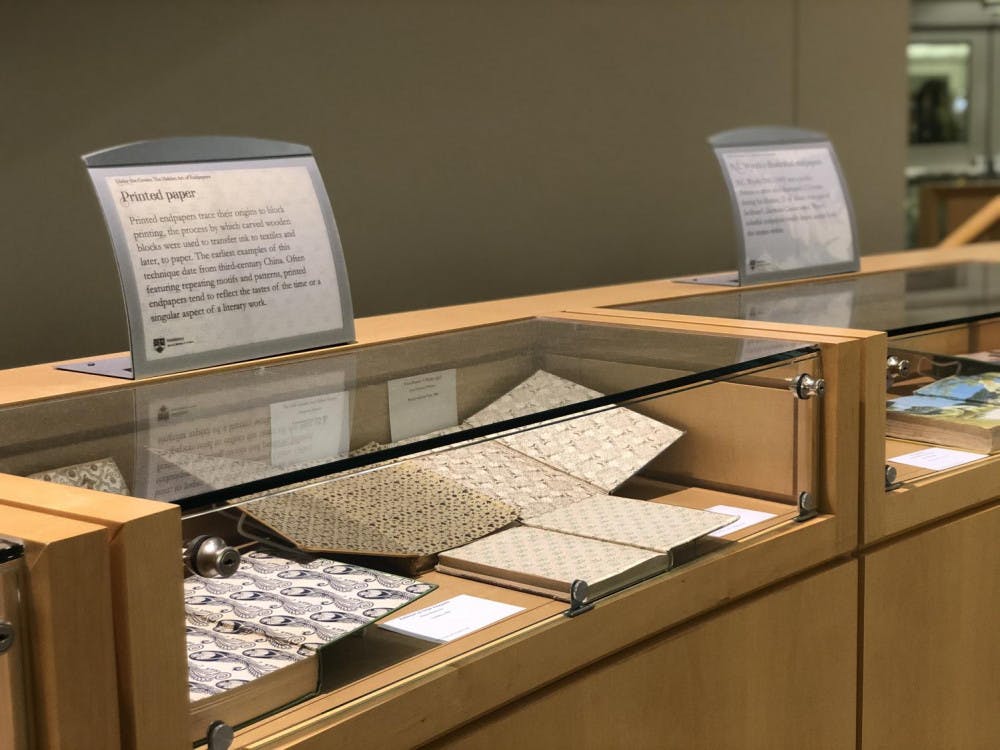In a time when Kindle is on the rise and most books are instantly accessible online, it has become a rarity for people to pick up hard-cover, good old-fashioned books. We have forgotten to appreciate the age-old craft of bookmaking in the midst of a technological frenzy, and the hidden treasures inside these books have become as dusty in our minds as the shelves they sit upon.
“Under the Covers: The Hidden Art of Endpapers” reminds us of these forgotten treasures by outlining the history of endpapers, sheets of paper pasted onto a book’s inside covers. In the 15th century, endpapers simply served the purpose of protecting the first and last pages in books; however, as time went on, they began to be seen as works of art. From the earliest minimalistic paste papers to the increasingly common applications of marbling, printing, illustrating and modern-day photography, the exhibit shows the evolution of endpapers through the centuries, succeeding in reigniting an appreciation for what is hidden in plain sight.
“With this exhibit, we wanted to showcase books not just as neutral containers for any old text but as a material object that tells stories of the time and place that it first came into being,” said Rebekah Irwin, Special Collections & Archives director and curator of the exhibit. “When I look at a book, the text — the actual words under the covers — is rarely what I look at first. Especially old books. I look at the binding, the feel of the paper, the heaviness of the book, the smell (yes, old books do have a unique smell!). I also look for illustrations, annotations and doodles, and I always look for remarkable endpapers.”
Irwin adamantly believes that the physical features of books serve as a looking glass into its history. “We might remember the story of Dr. Suess’s “The Lorax,” but do we remember the freaky endpapers? Or the showy and spectacular decorated papers popular in the 1700s through the 1900s?” asked Irwin. “Our hope is that our exhibit sends you back to your shelves to open up long neglected books. Not to read them of course, but to take a closer look at the book and to see it, rather than read it — especially the endpapers. I suspect we all have at least a few surprises on our bookshelves if we took the time to look under the covers for these concealed works of art.”
Kaitlin Buerge ’13, special collections and archives fellow, discussed her experience working on the exhibit.


“Selecting books for this exhibit was the best. In my head, I’ve been referring to the process as ’shopping’ the stacks, because I would venture into our rare books section and try to guess which kinds of spine and covers might suggest beautiful endpapers within,” Buerge said in an email to The Campus. “I started to recognize that books with more expensive-looking bindings would often have marbled endpapers, but I was often surprised by the marbling hiding inside books with much plainer, old-looking (17th and 18th century) covers.”
Buerge recalled that while she was a college student, museum and library exhibitions rarely caught her attention. Yet through the eye-catching glass cases in Davis Library, she hoped students could spend some time enjoying “a glimpse of N.C. Wyeth’s illustrations or the marbled endpapers.” Often overlooked, Buerge sees this exhibition as an opportunity to give endpapers the overdue credit they deserve.
“Under the Covers: The Hidden Art of Endpapers” is on display in the Davis Library atrium now through May 31, 2020. Whether you stop in for a quick visit on a study break or are inspired to look a bit more closely at the books lining your desk back home, the endpapers display reminds us to acknowledge the aspects of our lives that take a little more work to find and understand. If we all challenge ourselves to seek these surprises hidden on our bookshelves and in our lives, who knows? The worlds around us and the worlds written, hardbound in our palms, may just become a little more exciting.
'Under the Covers: The Hidden Art of Endpapers'

RAIN JI/THE MIDDLEBURY CAMPUS
Comments



